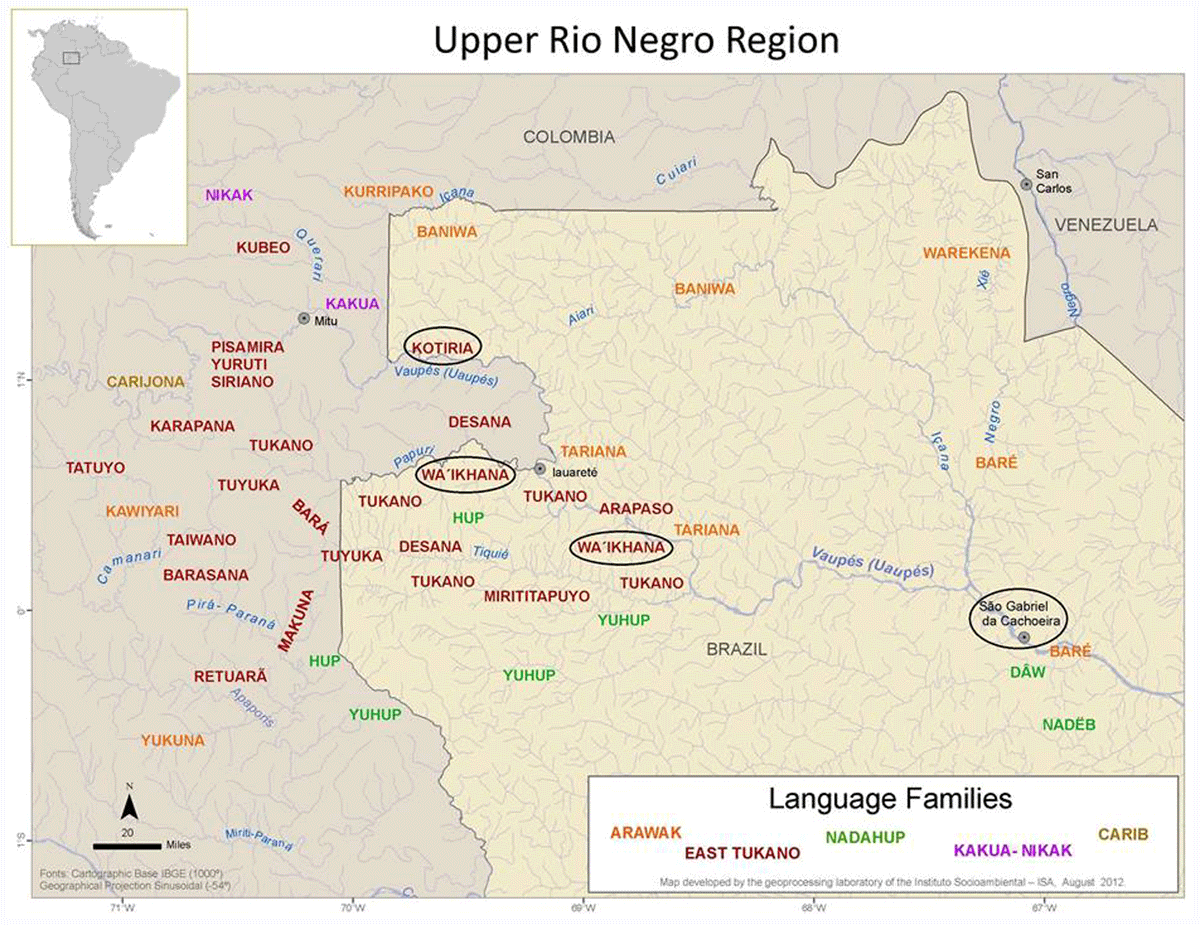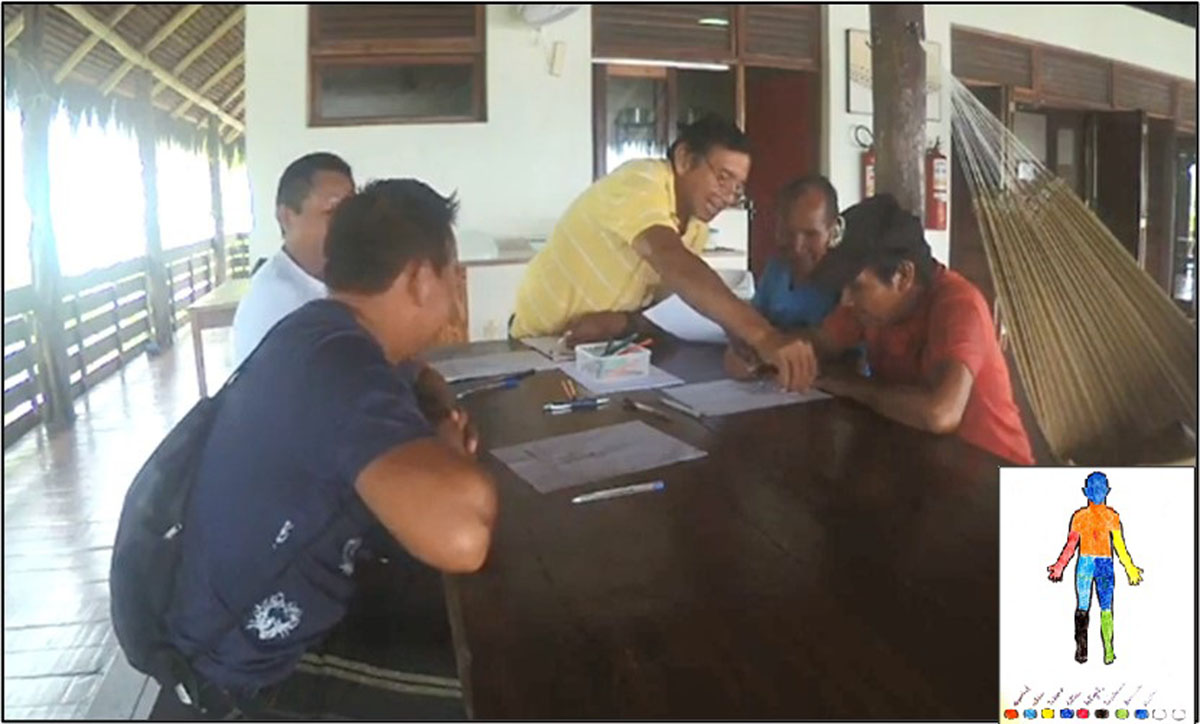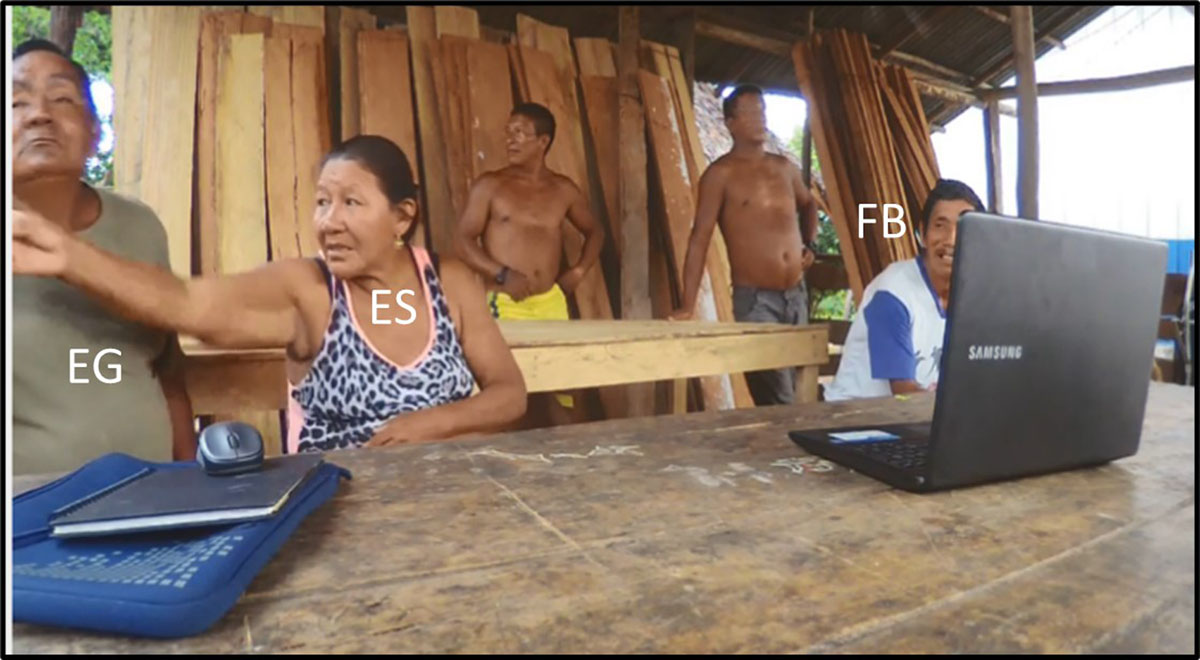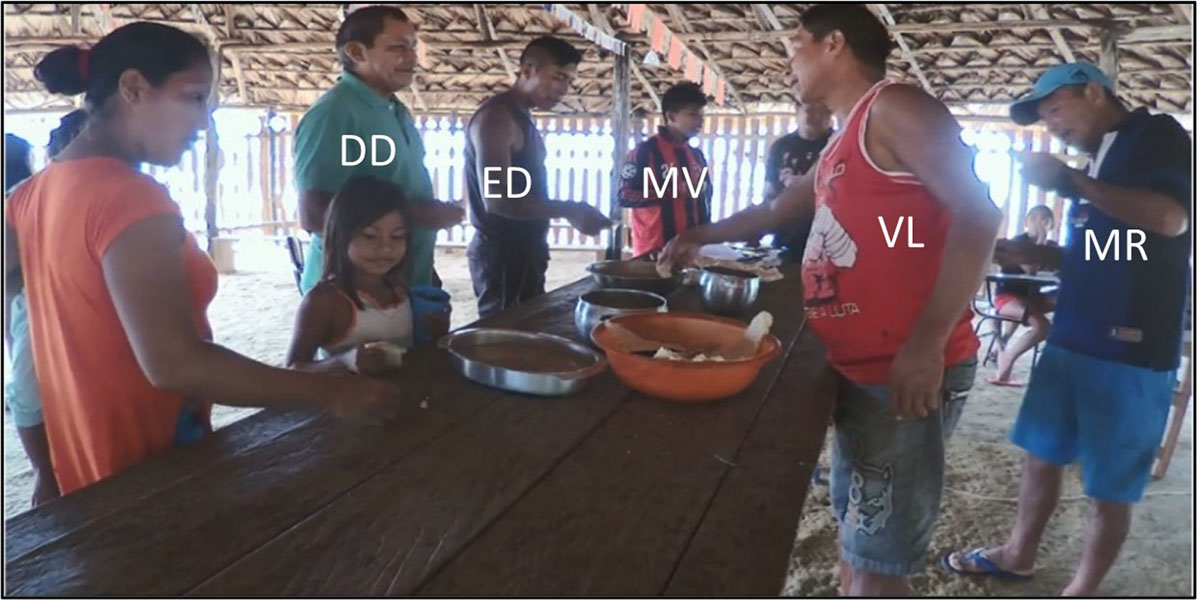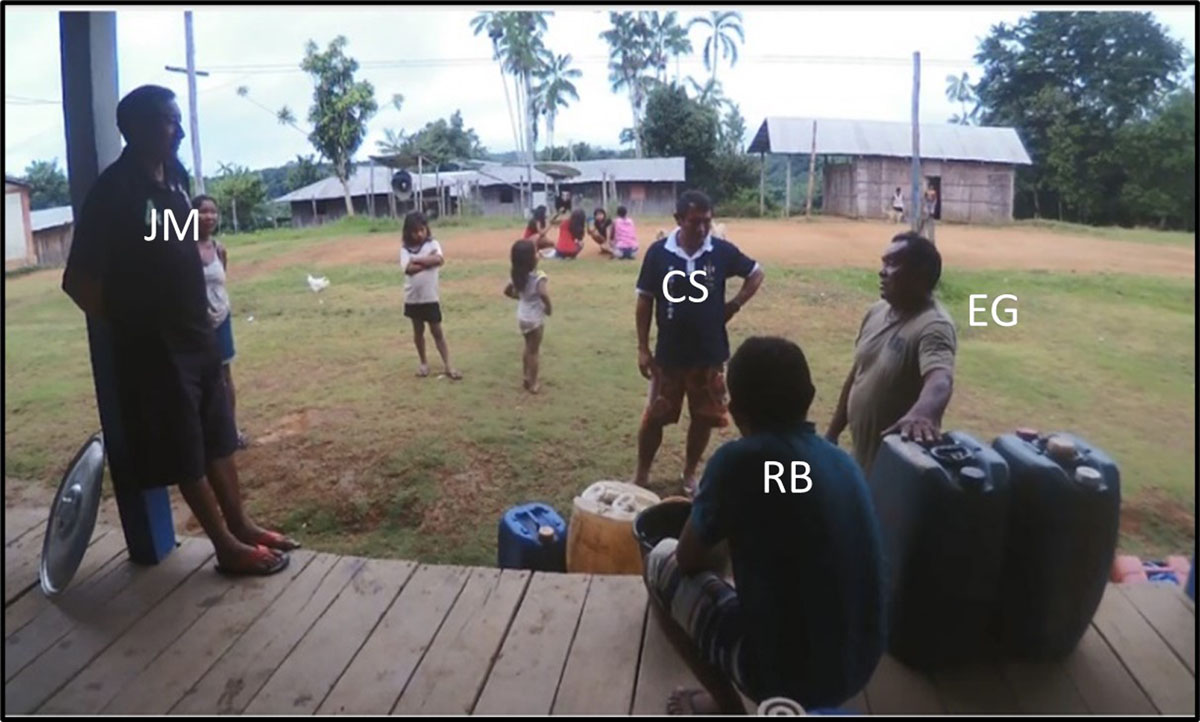1. Introduction
The use of constructions framing utterances as talk produced by others is a notably prevalent feature of all types of speech contexts in Kotiria (Wanano/Guanano, ISO gvc) and Wa’ikhana (Piratapuyo, ISO pir), languages that form a subbranch of the sixteen East Tukano languages spoken in the Upper Rio Negro region of northwestern Amazonia (Chacon 2014). These languages are closely related, mutually intelligible, and were the joint focus of extensive documentation carried out by the authors between 2017–2020 and which resulted in a documentary corpus comprised primarily of everyday conversations. This corpus constitutes a unique window into language use and investigation from both structural and interactional perspectives. The present study does just that, looking at direct speech (or quotative constructions), a particularly interesting topic of investigation in Kotiria and Wa’ikhana given that quotation is the primary resource for reference to talk.
We begin with an overview of the structure of quotatives in Kotiria and Wa’ikhana (Section 2), showing them to be prototypically biclausal, with a main clause speech verb serving to introduce or frame the embedded quoted speech, and displaying inflectional and pronominal shifts that identify and index the quoted speaker. However, we also show that framers (if present at all) take many shapes and that participants can be identified in a variety of ways. We moreover observe that there are no restrictions on what can be quoted—a full range of sentence types are found in direct speech, in addition to other turn shapes that occur in interactional contexts. In this section, we also briefly discuss reported evidentials—one of the (four to six) evidential categories in East Tukano languages—as a secondary, and much less frequently used, means of reference to speech.
Section 3 shifts focus to usage, with discussion of three excerpts from everyday conversations involving Kotiria and Wa’ikhana speakers in which direct speech plays an important role. In Section 3.1, we see that in the highly multilingual context of daily life, use of direct speech often entails an additional layer of complexity in that speakers can opt to portray the speech of others in different languages, a determination sensitive to both immediate interactional concerns and broader ideological norms related to code-switching. Double embedding of quoted speech as found in the excerpt in Section 3.2 shows how speakers can use quotation to distance themselves from socially delicate content. Finally, the excerpt in Section 3.3 demonstrates how skillful alternation between declaratives and quotatives in storytelling contributes to speakers’ ability to present and deploy different points of view, epistemic stances, and social responsibilities through broader access to finite clause modality markers.
The discussion in Section 4 contextualizes observations on Kotiria and Wa’ikhana quotatives in a crosslinguistic perspective and emphasizes the need to further address how and why speakers deploy quotation as an interactional resource (cf. Holt & Clift 2007). Our investigations of quotation as a pragmatic tool in interaction and consideration of multilingualism as an additional facet of direct speech make this study a unique foray into a new realm of investigation of language use.
Figure 1 shows the traditional locations of the Kotiria and Wa’ikhana in the Upper Rio Negro region, which spans a vast area of Brazil-Colombia borderlands. It also identifies the main urban center and seat of the municipality, São Gabriel da Cachoeira, to which many members of both groups have migrated from their traditional villages in the Vaupés River basin over the past several decades and where part of the data presented in this study was collected.
Map of the Upper Rio Negro, with locations of the Kotiria and Wa’ikhana, and the city of São Gabriel da Cachoeira (Epps & Stenzel 2013: 10).
All examples in this article come from the authors’ fieldwork materials. Specific data on quotative constructions was collected in September, 2019 in São Gabriel da Cachoeira, and additional examples are drawn from publications and materials in the ELAR documentation archives for Kotiria (https://www.elararchive.org/dk0137) and Wa’ikhana (https://www.elararchive.org/dk0138), and the corpus of interactional data currently being deposited (https://www.elararchive.org/dk0491).
2. Tools for Referencing ‘Talk’ in Kotiria and Wa’ikhana
All languages have grammatical means indicating reference to speech itself—whether one’s own or talk produced by others—that include lexical and morphosyntactic resources and varying distinctions, such as the non-universal differentiation between direct and indirect speech. Here, we discuss the two basic grammatical tools available for reference to talk in Kotiria and Wa’ikhana: quoted speech and reported evidentials, the latter spanning the semantic domains of reported speech and grammaticalized evidentiality.
2.1 Quoted speech: structure, features, distribution
The templatic structure of monoclausal sentences in Kotiria and Wa’ikhana is shown in (1), with the finite verb constituting the only obligatory element. The pre-verbal position is important for our discussion, as it is typically occupied by a syntactic object (patient, recipient, benefactive) or a nominalized complement of an auxiliary verb in constructions such as progressives and purposives (see (8b) below; cf. Stenzel 2013: chapter 11).1
| (1) | Temporal Adj.; New/topical S; Focused element |
Obj 1PAT / Obj 2RECIP/BEN; referential -re; non-referential unmarked |
(nominalized) complement |
VERB w/finite inflection |
Locative Adj.; Known Subject (PRONOMINAL) |
Although sentences that include quoted speech are biclausal, the template and examples in (2) show that their construction mirrors (1) in that quoted speech, embedded and with its own finite marking, most often occurs in the pre-verbal, object/complement position. The Quoted speaker (Q-speaker) is usually identified at the end of the sentence (e.g., “‘ABC,’ said X.” as in (2a) and (2b)). However, positioning of the referential Q-speaker and Q-addressee (participant grammatically marked by the OBJ suffix -re) varies enormously—if those participants are overtly identified at all.
- (2)
- “Quoted speech (w/finite inflection)”
- Speech verb (w/finite inflection)
- Q-speaker
- a.
- KOTIRIA
- wa’ire chʉi nire Dora2
- wa’í-re
- fish-OBJ
- chʉ́-i
- eat-VIS.PFV.1
- ~dí-re
- say-VIS.PFV.2/3
- Dora
- “I ate fish” Dora said.3
- b.
- WA’IKHANA
- wa’i i’yatuasʉʉ nidi Dora
- wa’í
- fish
- i’yá-tuasʉ́-ʉ
- eat-finish-VIS.PFV.1
- ~dí-di
- say-VIS.PFV.2/3
- Dora
- “I just ate fish” Dora said.
- Both sentences were given for the indirect speech sentence prompt in Portuguese Dora disse que comeu peixe ‘Dora said (that) she ate fish.’
The template and examples in (3) show the second most common ordering of constituents, in which the quoted speaker and speech verb precede the quoted speech.
- (3)
- Q-speaker
- Speech V (inflected)
- (Q-addressee)
- “quoted speech (w/finite inflection)”
- (Q-addressee)
- a.
- KOTIRIA
- Dora nire wa’ire chʉi yʉ’ʉ
- Dora
- ~dí-re
- say-VIS.PFV.2/3
- wa’í-re
- fish-OBJ
- chʉ́-i
- eat-VIS.PFV.1
- yʉ’ʉ́
- 1SG
- Dora said: “I ate fish.”
- b.
- WA’IKHANA
- Dora õsa nidi wa’i i’yaʉ
- Dora
- ~ósa
- like.this
- ~dí-di
- say-VIS.PFV.2/3
- wa’í
- fish
- i’yá-ʉ
- eat-VIS.PFV.1
- Dora said (like this): “I ate fish.”
- Both sentences were given for the direct speech prompt in Portuguese Dora disse: “Eu comi peixe.” ‘Dora said: “I ate fish.”’
Additional orderings and constituencies are summarized in (4), the final column indicating which examples in this article exhibit each ordering/constituency. These alternatives tend to occur in contexts of extended dialog, sequences in which both speech verbs and identification of participants (with proper names, lexical nouns, or pronominals) are optional.
- (4)
- a.
- Q-speaker
- “quoted speech”
- Speech V (uninflected)
- b.
- “quoted speech”
- Speech V (uninflected/inflected)
- (Q-speaker/addressee)
- (9c), (13)
- c.
- (Q-speaker/addressee)
- “quoted speech”
- (19) lines 1+4
- d.
- “quoted speech”
- (9b), (14)
The sentences in (2) and (3) were produced as biclausal quotative constructions with first-person inflection regardless of whether the elicitation prompt (in Portuguese) had a direct or indirect (third person) structure. Kotiria and Wa’ikhana have no complementizers such as the Portuguese que ‘that’, nor are there shifts of pronominal, temporal, and spatial reference indicating a change in perspective from the original speaker’s utterance to that of the current speaker that might signal indirect speech. Throughout extensive elicitation, speakers consistently neutralized the indirect/direct distinctions in the Portuguese prompts, and, except for order variations (preposing of the Q-speaker often mirrored the elicitation prompts), produced quoted speech recognizable through references presented as “faithful” to the original speaker’s perspective (Coulmas 1986: 2; Aikhenvald 2008: 383). In Kotiria and Wa’ikhana, these include both the person-referencing inflection on the quoted speech verbs and other indexing constituents, such as the possessed noun ‘your chicken’ in (5).
- (5)
- a.
- KOTIRIA
- mʉ kharaka du’tiawa’are nire yʉ marechõ
- ~bʉ=kháráká
- 2SG.POSS=chicken
- du’tía-wa’a-re
- escape-go-VIS.PFV.2/3
- ~dí-re
- say-VIS.PFV.2/3
- yʉ=~barécho
- 1SG.POSS=mother-in-law
- “Your chicken escaped,” said my mother-in-law.
- b.
- WA’IKHANA
- mʉ’ʉ yakodo kanaka du’tiawa’adi nidi yʉ’ʉ mareono
- ~bʉ’ʉ́
- 2SG
- yá-kodo
- POSS-SGF
- ~kadáká
- chicken
- du’tíá-wa’a-di
- escape-go-VIS.PFV.2/3
- ~dí-di
- say-VIS.PFV.2/3
- yʉ’ʉ ~báreodo
- 1SG mother-in-law
- “Your chicken escaped,” said my mother-in-law.
- Both sentences were given for the indirect speech prompt in Portuguese Minha sogra disse que minha galinha fugiu ‘My mother-in-law said that my chicken escaped.’
Such shifts in person reference, whether evidenced in verbal inflection or use of overt pronominal forms (e.g., the third-person pronouns tiro/tikido in (7) below), are the most consistent clues signaling quoted speech. Examples (6) and (7), for instance, were elicited as indirect speech with different referential values for the proper name and third-person pronoun; Nick=he in (6) and Nick≠he in (7). Nevertheless, speakers produced quoted speech with appropriate grammatical shifts for both: the shift to first person verbal inflection in (6) indicates coreferentiality within the quoted clause, while in (7), the third person pronominals tiro/tikido and non-first person inflection code non-coreferentiality.
- (6)
- a.
- KOTIRIA
- Nick nahure chʉi nire
- Nick
- ~dahú-ré
- beiju-OBJ
- chʉ́-i
- eat-VIS.PFV.1
- ~dí-re
- say-VIS.PFV.2/3
- Nickj: “Ij ate beiju” (he) said.
- b.
- WA’IKHANA
- nahure i’yaʉ nidi Nick
- ~dahú-ré
- beiju-OBJ
- i’yá-ʉ
- eat-VIS.PFV.1
- ~dí-di
- say-VIS.PFV.2/3
- Nick
- “Ij ate beiju” said Nickj.
- Both sentences were given for the indirect speech prompt in Portuguese Nick disse que comeu beiju ‘Nickj said hej ate beiju (a type of flatbread).’
- (7)
- a.
- KOTIRIA
- tiro nahure chʉre nire Nick
- tí-ró
- ANPH-SG
- ~dahú-re
- beiju-OBJ
- chʉ́-re
- eat-VIS.PFV.2/3
- ~dí-re
- say-VIS.PFV.2/3
- Nick
- “Hek ate beiju” said Nickj.
- b.
- WA’IKHANA
- tikido nahu i’yadi nidi Nick
- tí-kídó
- ANPH-SG
- ~dahú
- beiju
- i’yá-di
- eat-VIS.PFV.2/3
- ~dí-di
- say-VIS.PFV.2/3
- Nick
- “Hek ate beiju” said Nickj.
- Both sentences were given for the indirect speech prompt in Portuguese Nick disse que ele [outro] comeu beiju ‘Nickj said hek ate beiju.’
Thus, speakers of Kotiria and Wa’ikhana only reference talk using direct quotation, its use being highly diversified. Indeed, direct quotation occurs throughout all kinds of discourse, including everyday conversation, and all sentence types can be quoted. Framers likewise take many shapes, and participants can be identified in a variety of ways.
Table 1 gives the speech verbs employed to introduce or frame quoted speech, which are cognate in both languages. The most frequent is ~di ‘say’, which has semantics generic enough to allow its use to introduce quoted talk or quoted thought in virtually any type of speech situation. The other verbs listed emphasize specific types of speech acts (e.g., the request with ~sidí in (8c) below).
Kotiria and Wa’ikhana Speech Verbs.
| ~di | say (sing, chant, think, ask, answer, tell, etc.) |
| ~sidí(tu) | ask for, request, demand |
| yu’tí | answer |
| ya’ú | tell, warn |
| thʉ’ótu | think, imagine, wonder |
Though common, speech verbs are nevertheless contextually dispensable. In narratives, for example, speaker-narrators often “animate” (cf. Goffman 1981: 145) the talk of different characters for extensive periods with limited use of framing verbs, the short sequence in (8) being a typical example. Here, we see dialog framed only by use of the participants’ names: speaker Ñahori and addressee Yuhpi Diani. Although (8a) has no explicit speech verb, the pronominal and inflectional shifts to first-person in (8b) make it recognizable as quoted speech by Ñahori. The speech verb ~sidi ‘ask for/request’ in (8c) frames Yuhpi Diani’s (equally first-person) response in (8d). Repetition of the generic speech verb ~dí in the final line of talk is a common discourse-organizing tool indicating the end of the dialog sequence (see also (9) below).
- (8)
- KOTIRIA (Stenzel et al. 2017: 203–4, lines 26–29)
- a.
- tiro ñahori, a’riro yuhpi dianine:
- tí-ró
- ANPH-SG
- ñáhórí
- a’rí-ro
- DEM.PROX-SG
- yuhpí.diáni-re
- YD-OBJ
- So (they’re saying) that Ñahori lived just there (and said) to Yuhpi Diani:
- b.
- numia yʉ’ʉ́ nai wa’ai niha, yʉ buhibo
- ~dúbí-á
- woman-PL
- yʉ’ʉ́
- 1SG
- ~dá-i
- get-1/2M
- wa’á-i
- go-1/2M
- ~dí-há
- PROG-VIS.IPFV.1
- yʉ=buhíbo
- 1SG.POSS=sister.in.law
- “I’m going to get women, my sisters-in-law” (eligible women from an affinal group, commonly referred to as ‘in-laws’)
- c.
- nichʉ, tirota sinikaatia:
- ~dí-chʉ
- say-SWRF
- tí-ró-ta
- ANPH-SG-EMPH
- ~sidí-ka’a-ati-a
- ask.for-do.immediately-IPFV-ASSERT.PFV
- When (Ñahori) said that, (Yuhpi Diani) requested:
- d.
- yʉ’ʉkhʉre kʉ̃koro natanamoa niatia
- yʉ’ʉ́-khʉ́-ré
- 1SG-ADD-OBJ
- kʉ́̃-kó-ró
- one/a-F-SG
- ~dá-ta-~dabo-(g)a
- get-come-wife-IMP
- ~dí-ati-a
- say-IPFV-ASSERT.PFV
- “(Get) another captured wife for me too” asking/ordering (Ñahori).
Any kind of speech act can constitute a quote. Looking briefly at sentence types, besides realis declaratives, for which evidential marking constitutes finite inflection (e.g., the “inference” and “assertion” markers in (9b) and (9c)), quoted speech can contain interrogatives, as in (9a), framed by the explicit verb ~sidítu ‘ask for/demand’. In this sequence, speaker identities are inferred from context, with only the contrastive marker -se’e on the third-person pronominal in (9c) signaling the change of speaker.
- (9)
- KOTIRIA (Stenzel 2013, texts: 6.56–59)
- a.
- mʉmʉ mahasʉ̃ tirore sinitua: mʉ’ʉ ñʉerari yʉ mahkʉre?
- ~bʉbʉ́
- run
- ~bahá-~sʉ́
- go.uphill-arrive
- tí-ró-ré
- ANPH-SG-OBJ
- ~sidítu-a
- ask-ASSERT.PFV
- ~bʉ’ʉ́
- 2SG
- ~yʉ-éra-ri
- see-NEG-INT
- yʉ=~bakʉ́-ré
- 1SG.POSS=child.M-OBJ
- (A snake-man) running up to him (the man) asked: “Didn’t you see my son?”
- b.
- wãharokari hire wa’ikinawãharo wa’arirore, pʉ wa’ikinawãharo wa’arirore.
- ~wahá-roka-ri
- kill-DIST-NMLZ(INFER)
- hí-re
- COP-VIS.PFV.2/3
- wa’í-~kídá-~wáhá-ró
- animal-PL-kill-(3)SG
- wa’á-ri-ro-re
- go-NMLZ-SG-OBJ
- pʉ́
- LOC
- wa’í-~kídá-~wáhá-ró
- animal-PL-kill-(3)SG
- wa’á-ri-ro-re
- go-NMLZ-SG-OBJ
- “(It seems) he was killed when he was off hunting, when far away hunting.”
- c.
- ñʉera ti mahsieraka yʉ’ʉ nia tirose’e.
- ~yʉ-éra
- see-NEG
- ti-(ro)
- ANPH-(SG)
- ~basi-éra-ka
- know-NEG-ASSERT.IPFV
- yʉ’ʉ́
- 1SG
- ~dí-a
- say-ASSERT.PFV
- tí-ró-sé’é
- ANPH-SG-CONTR
- “I didn’t see (anything/anyone), I know nothing (about it)”, he (the man) said/answered.
Quoted questions also appear in the following excerpt from a (multilingual) conversation between a husband (EG) and wife (ES) in (10). Both quotes contain EG’s suggestions for what his wife should ask a guest arriving at their house and are framed by the generic ‘say’ verb.
- (10)
- KOTIRIA and TUKANO (iauk_002 00:31:46–49)
- a.
- almoçaride mʉ’ʉ niga[KOTIRIA]
- EG:
- almoçáPOR-ri-de
- have.lunch-INT-EMP.2
- ~bʉ’ʉ
- 2SG
- ~di-ga
- say-IMP
- “Have you eaten?” say/ask (her, a guest arriving at the house)
- b.
- ba’a-põ[TUKANO] koa[KOTIRIA]
- ES:
- ba’a-po
- eat-INF.REC.PST.3SG
- koa
- perceive
- Seems she already ate.
- c.
- ã sinituna nimano chʉerari, chʉri[KOTIRIA] KOTIRIA
- EG:
- ~a
- so/then
- ~siditu-ra
- ask-VIS.IMPERF.2/3
- ~di-~ba-do
- say-POL-SG
- chʉ-era-ri
- eat-NEG-INT
- chʉ-ri
- eat-INT
- So, ask politely: “Did you not eat (or) eat?”
Different kinds of directives can also be quoted, e.g., the imperatives in (8d) above and (11) below. Declarative, interrogative, and directive sentence types are recognizable by finite inflectional morphology on the verb in the quoted speech.
- (11)
- KOTIRIA (tcpk_063 00:11:47)
- õse nia, hʉ̃chʉɡʉ sʉ̃ebiara nia
- ~ose
- be/do.thus
- ~di-(g)a
- say-IMP
- ~hʉchʉ-gʉ
- roast-IMP.M
- ~sʉebia-ra
- be.sour-VIS.IPFV.2/3
- ~di-(g)a
- say-IMP
- Tell (him): “Roast it, it’s sour”, say (that). (A man addressing his wife, who was going to deliver some food to a neighbor)
Kotiria and Wa’ikhana speakers also regularly use quotative constructions for different types of internal talk. This may be the speakers’ own thinking, wondering, wishing, etc., as seen in (12), or the thoughts of protagonists in narrator speech, as is the case in (13). Parallels between external/internal speech are cross linguistically common, as is the fact that quoted thoughts may be identified by a generic speech verb, such as the ~di employed in both examples.
- (12)
- WA’IKHANA (Stenzel et al. 2019: 407, line 16)
- wehsepʉ, buu i’yali. saayeegʉ ko’tei wa’aʉ nii.
- wesé-pʉ
- garden-LOC
- buú
- agouti
- i’yá-di
- eat-VIS.PFV.2/3
- saá-yéé-gʉ́
- so-do-1/2SGM
- ko’té-i
- wait-1/2SGM
- wa’á-ʉ́
- go-VIS.PFV.1
- ~dí-í
- say-VIS.PFV.1
- There in the garden, an agouti had been eating (the manioc). So, “I’m going to wait (for it, to hunt it)” I said/thought.
- (13)
- KOTIRIA (Stenzel 2013, texts: 7.28)
- yabariro hikari hi’na ni tiro.
- yabá-rí-ró
- Q-NMLZ-SG
- hí-kari
- COP-INT.SUPP
- ~hí’da
- EMPH
- ~dí
- say
- tí-ró
- ANPH-SG
- “Who could that be!?” (the man) said/thought/asked himself (upon hearing a strange noise coming from the forest at night).
Interactional data reveal a further use of quotative constructions to demonstrate how someone else should understand or think about something. This is illustrated in (14), where a Wa’ikhana man (MC) was giving instructions to a group completing language portraits during a sociolinguistic interview (Figure 2).3 Part of the portrait task is to color in a silhouette of a human body using different colors to represent the languages in one’s linguistic repertoire and then identify each language in a key at the bottom (see insert in Figure 2). Some of the participants were unclear about what to do, but instead of using a directive, such as “Here is where you list all the languages you know,” or providing an external example, such as “In my case, here I listed … ”, MC used direct speech to enact the internal thoughts of someone remembering the languages they use in different situations, such as when flirting with a sweetheart. Indeed, the language used to romance one’s partner reflects an important facet of the multilingual makeup of Vaupés society and norms prescribing exogamic marriages (Epps & Stenzel 2013; Stenzel 2005). A potential mate must come from a different ethnolinguistic group; thus, successful romancing may entail feats of multilingual prowess! A final interesting element in (14c) is the term used for ‘woo’, a serial verb construction ya’u-sa-dʉhka, literally ‘to talk your way into’ someone’s heart.
- (14)
- WA’IKHANA (sgcw_007-1 27:37–46)
- a.
- a’li ihide yʉ’ʉ ya’uduhkuye
- a’dí
- DEM.PROX
- ihí-de
- COP-VIS.IPFV.2/3
- yʉ’ʉ
- 1SG
- ya’údúhkú-ye
- language-PL
- “These are my languages”
- MC: ((pointing to where languages should be identified on the portrait))
- b.
- yʉ’ʉ namorada me’na, yʉ’ʉ ya’usãgʉ̃
- yʉ’ʉ
- 1SG
- namorada[POR]
- girlfriend
- ~be’da
- COM
- yʉ’ʉ
- 1SG
- ya’ú-~sa-~gʉ
- speak-mov.inside-1/2M
- “with my girlfriend, when I was wooing her”
- c.
- a’li linɡua yʉ’ʉ ya’usadʉhketiya
- a’dí
- DEM.PROX
- linɡuaPOR
- language
- yʉ’ʉ
- 1SG
- ya’ú-sá-dʉ́hká-étí-aya
- speak-MOV.inside-begin-IPFV-assert.ipfv
- “this is the language I started wooing (her with)”
We note that no verbal framers are employed in this sequence of sentences; the shift to direct speech is understood by MC’s use of first-person pronominals and inflectional markers. This kind of practice, sometimes called animation, has been studied from a range of perspectives (see Cantarutti 2020; Goffman 1981).
2.2 Reported evidentials
In addition to direct quotation, Kotiria and Wa’ikhana speakers can also use reported evidentials to identify talk as a (non-firsthand) source of information.4 Both languages have two reported evidential suffixes, shown in Table 2. The difference in forms codes whether the speaker is referencing a specific or diffuse secondhand source; in either case the referent is not explicitly identified.
Reported evidential forms in Kotiria and Wa’ikhana.
| KOT | WAI | |
|---|---|---|
| diffuse referent(s) | -yu’ti | -~yo’ti |
| specific referent(s) ‘quotative/speaking for X’ | -yu’ka | -aye |
Utterances with reported speech morphemes are difficult to elicit and are rare in narrative discourse. However, a diffuse reported marker was spontaneously used in (15) by a Wa’ikhana consultant during elicitation for this article, and the Kotiria quotative form in (16) was used early in a narrative-telling session at a community language workshop. Reported evidentials are much more frequent in conversational contexts, such as (17). We should note that in (15), the reported evidential is used within the quoted speech, as the finite marking on the verb ~kadi ‘sleep’; thus, it is not used as a tool for quoting talk, but instead implies that the subject, Roberto, is making the statement based on information he heard from others. In contrast, in (16) and (17), the -yu’ka suffixes occur on the main verbs, but only in (17) is this a speech verb with a quoted speech complement. Consultants affirm that the -yu’ka/-aye forms evoke a kind of “quotative” understanding: that the speaker is speaking for someone else or giving voice to an entity—such as the duckling in (17)—that cannot speak for itself. The boy’s choice of reported rather than visual evidential (~dira) on the speech verb ‘say’ is likely because he is clearly animating the thoughts/speech of a non-human.
- (15)
- WA’IKHANA
- tikoro ne kaniedaño’ti kanupʉle nidi Roberto.
- tí-kódó
- ANPH-SGF
- ~de
- NEG
- ~kadi-eda-~yo’ti
- sleep-NEG-REP.DIFF
- ~kadu-pʉ-de
- last.night-LOC-OBJ
- ~dí-di
- say-VIS.PFV.2/3
- Roberto
- Roberto said: “(People said/are saying) she didn’t/couldn’t sleep last night.”
- (16)
- KOTIRIA (Stenzel et al. 2017: 198 (12))
- tire a’rina thʉ’oduayu’ka.
- tí-re
- ANPH-OBJ
- a’rí-~da
- DEM.PROX-PL
- thʉ’ó-dua-yu’ka
- hear-DES-REP.QUOT
- These (visitors) want to hear (stories). (I’m told/repeating what X said)
- (17)
- KOTIRIA (tcpk_063: 03:38)
- mʉmʉtinii niyu’ka.
- ~bʉbʉ́-~tídí-i
- run-MOV.circular-VIS.PFV.1
- ~di-yu’ka
- say-REP.QUOT
- “I’m running away!” (ducky) says. (Context: a family is talking in their yard when a duckling runs past; the boy producing the utterance is “speaking for” the duck)
As with other forms of quotation in Kotiria and Wa’ikhana, reported evidentials do not yield any kind of indirect speech interpretation or shift in perspective; indeed, the first-person inflection in Ducky’s speech in (17) clearly establishes it as directly quoted, albeit by proxy. These examples moreover demonstrate that reported evidentials may, but do not necessarily, reference speech events themselves; rather they infer speech as a source of information when talking about things for which one has no direct evidence.
3. From Structure to Pragmatics: Exploring Quotatives in Interaction
Most research on direct/quoted speech has focused on its structural form with particular attention paid to embedding and the deictic shifts by which it is recognized in many languages. While work on the pragmatic functions of quoted speech has increased recently (e.g., Buchstaller & van Alpen 2012; Holt & Clift 2007), the topic remains understudied, especially in lesser-known languages like Kotiria and Wa’ikhana.
In this section, we look at three extracts from a corpus of informal interaction in Kotiria and Wa’ikhana in which direct speech is prominent. These extracts have been chosen because they reveal additional layers of complexity in structural aspects of quotatives and offer some initial insights into the pragmatics of quotation in everyday talk, the most basic and frequent form of language use.5
3.1 Code choice in quoted speech
Extract (18) is from a multilingual Kotiria/Tukano conversation in which the choices of languages used in quotation demonstrate differential orientation to two purported norms of multilingual speech in the Vaupés. The first is that while code-switching is generally eschewed, it is allowed in quotation (including self-quotation) with the expectation that it will faithfully reproduce the original speaker’s language choice. The second is that in conversations among people with overlapping language repertoires, each person should be loyal to their own language and use it preferentially, a practice known as “receptive” multilingualism (cf. Chernela 2013; Gomez-Imbert 1996; Stenzel & Williams 2021). Both practices occur in (18), but apparently in competition, with speakers orienting to them in different ways.
As people in the Kotiria village of Carurú-Cachoeira were gathering to watch a film, ES (ethnic Tariana, speaking Tukano, in the middle in Figure 3), her husband EG (ethnic Kotiria, speaking Kotiria, left), and FB (ethnic Desano, speaking Kotiria, right) look across the open plaza and ES points to someone (line 1), prompting the ensuing exchange.6
- (18)
- (crck_084 00:04–22) Tukano speech is double-underlined
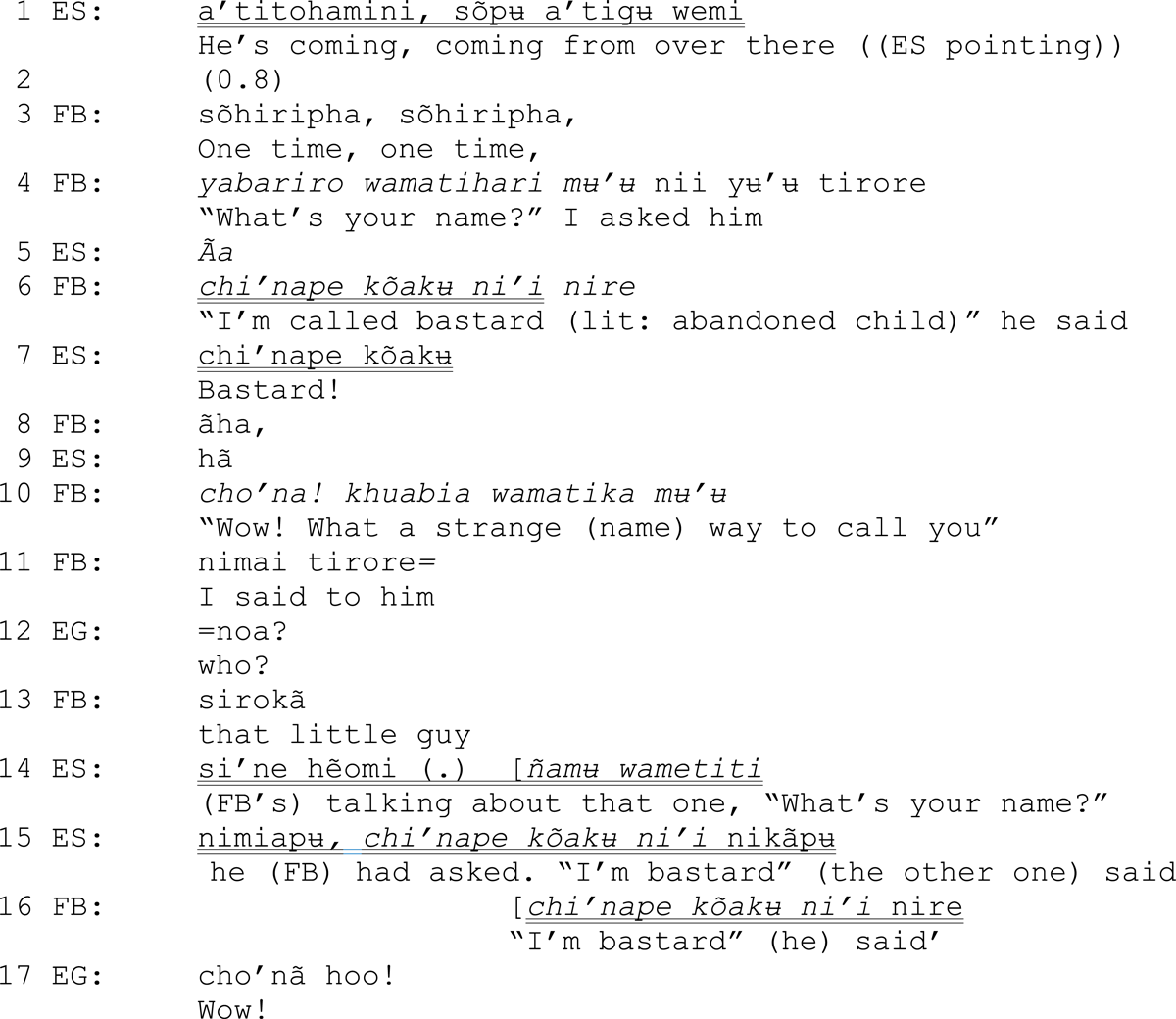
The first practice mentioned above occurs in lines 3–11, with FB reproducing a receptive multilingual exchange he once had with this person, who claimed to be called “Bastard” chi’nape kõakʉ, lit: ‘abandoned child’ (in Tukano). The quoted multilingual conversation consists of FB’s question in Kotiria (line 4), B’s answer in Tukano (line 6), and FB’s comment in Kotiria (lines 10–11). Embedding of multilingual quotation is clear in FB’s lines 6 and 16, where Bastard’s quoted response in Tukano is the clausal complement of the speech verb nire ‘he said’, in Kotiria. The conversation FB quotes in these lines is itself embedded into an ongoing receptive multilingual conversation in which FB and EG are speaking in Kotiria and ES is speaking in Tukano.
Competition between the two practices is triggered by EG’s request for clarification in line 12, to which both ES and FB respond, in overlap, in lines 14–16. Both employ quoted speech structures, but while FB’s line 16 continues to follow the norm of faithful multilingual quotation, ES’s version in lines 14–15 is entirely in her own language, Tukano, as the norm of language loyalty in receptive multilingual conversations would dictate.
Thus, in highly multilingual contexts such as the Vaupés, quotation in conversation entails an additional layer of complexity: the choice of which language to place in the mouth of another. While there may be additional interactional factors motivating FB and ES’s language choices in this extract, competition between ideological norms governing multilingual code-switching, e.g., faithful reproduction of quoted speech vs. loyalty in receptive multilingual talk, seem also to be at play.
3.2 Quotation and distancing
Extract (19) demonstrates another interesting facet of quoted speech use in Kotiria and Wa’ikhana conversation: it is a go-to tool in storytelling contexts involving socially sensitive or taboo content. The sequence comes from a multilingual conversation around a communal breakfast during a Wa’ikhana language workshop (see Figure 4). In line 1, DD launches a story that will turn out to be an off-color joke involving a play on words in Portuguese.
Here, quoted speech in Portuguese is attributed to both the main protagonist, a “Japanese man”, in lines 4, 9, and 13 (the punchline), and an unidentified interlocutor (line 11). However, the quotative structures in lines 4, 11, and 13 have sequences of the inflected Wa’ikhana speech verb. This double structural embedding both frames the direct speech in the joke and allows DD to attribute the original joke-telling itself to some other speaker (whose identity MV suggests in line 7).
- (19)
- (acpw_072 5:53-6:05) Wa’ikhana speech is double-underlined; other speech is in Portuguese.
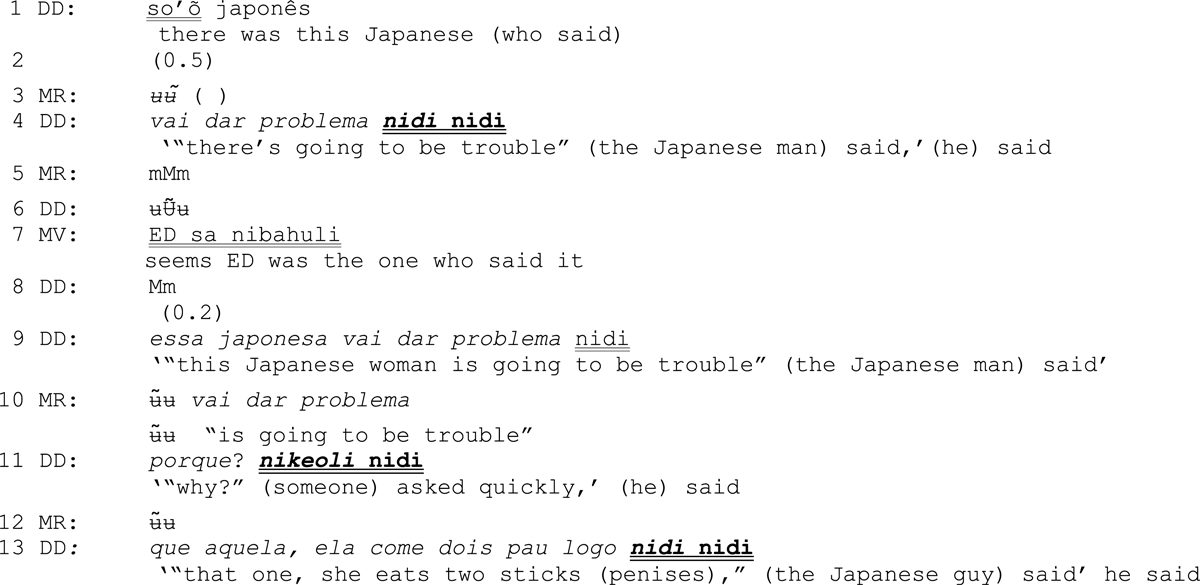
Given the joke format and the fact that it involves a play on words, we can easily understand both DD’s use of quotation and choice of quoted language. It is less clear why DD’s retelling involves structures with the observed double embedding, rather than, for example, use of a “diffuse” reported evidential (see Section 2.2 above). We suggest the choice is interactionally motivated in that it provides DD with an extra layer of distance from responsibility for the joke’s bawdy content, such distancing from taboo/delicate topics being a recognized function of quoted speech cross linguistically (cf. Bergmann 1993 on quoted speech and gossip, quoted in Holt & Clift 2007: 13). Indeed, there is evidence that DD’s interlocutors pick up on what might be coming in the story and aid his navigation of socially sensitive waters by encouraging and collaborating in the story’s production, e.g., MR’s “continuer/go-ahead” particles in lines 3, 5, and 12 (cf. Williams et al. 2020) and partial repetition in line 10.
3.3 The interplay of quotatives, evidentials, and other clause modality markers
Negotiating responsibility, albeit of a different nature, also factors in to how quotation is employed in extract (20), a short story told during a conversation between a group of Kotiria men who were transferring gasoline from a large tank to smaller receptacles for distribution (see Figure 5). The men had just concluded that the bucket they were using did not measure gasoline very accurately, and this prompted CS to recount how he once loaned gas to his neighbor, Senhor M. (Sr. M), using a similar, inaccurate bucket. From an interactional perspective, the interesting twist in the story is that it describes a morally tricky situation that benefited the teller, CS, in the end. Thus, ensuring his own role in the events is not viewed negatively is undoubtedly one of CS’s interactional goals in this telling. Indeed, this goal is masterfully accomplished through CS’s construction of what will emerge as the story’s main theses: (i) that everyone knows (or should know) such buckets are “bad”, (ii) that Sr. M did a dumb thing in choosing to use this kind of bucket, and (iii) that although CS profited from Sr. M’s choice, it was not his fault.
- (20)
- (crck_117 8:43–10:29)
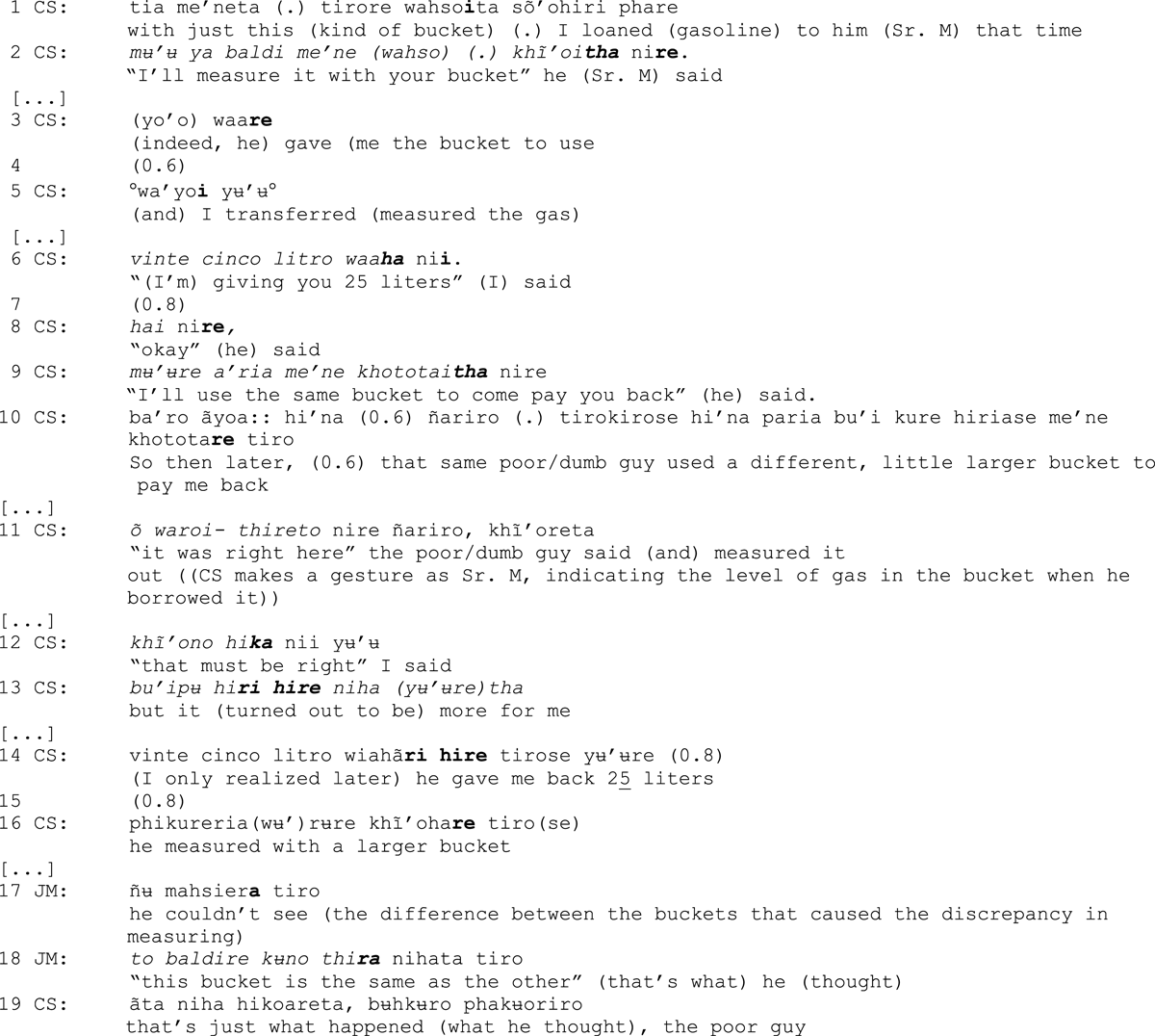
CS leads his interlocutors to align with his own rendition of events through skillful use of declarative and quotative constructions that support his theses. Recall that realis declaratives in Kotiria and Wa’ikhana are obligatorily coded by evidentials, and that the epistemic overtones these markers entail reflect the speaker’s perspective and relationship to events. Quotation, in contrast, allows the speaker to present events from someone else’s perspective, the finite marking in the quoted utterances duly shifting the epistemic stance and any entailed responsibility to the other person.7
When well employed, these are powerful interactional tools. For example, CS’s telling begins with a statement marked with a first-person visual evidential, -i in line 1, which ‘packages’ the story as a faithful representation of CS’s own (epistemologically unchallengeable) experience. His immediate shift to quotation of Sr. M with the first-person ‘intention’ marker -tha in line 2 (and again in line 9), on the other hand, effectively establishes the choice of which bucket to use as Sr. M’s responsibility. The visual marking in lines 3–8 shifts perspective back to CS, reinforcing the crucial point that he measured and loaned what he believed to be 25 liters of gas (but which was actually less because he was using the unreliable bucket) at Sr. M’s bidding.
As the storyline advances in line 10, however, CS states—again with visual evidential marking—that Sr. M didn’t use the same bucket to pay back the gas, the result being a windfall of extra gas for CS. Yet CS’s construction of the story continues to downplay any responsibility on his part. Note that CS now refers to Sr. M with the pejorative term ñariro ‘bad/dumb/pitiful guy’, and that both his return to quotation in line 11 and his accompanying gesture while speaking as Sr. M both underscore Sr. M’s agency in determining payback using a different bucket. CS’s self-quoted8 response (line 12) moreover has the assertion evidential, -ka, used for reasoned speculations. This strategic marking change underscores CS’s acquiescence to Sr. M’s decision and unawareness that the switch might result in anything amiss. CS’s incremental turns in lines 13–14 continue the work of diminishing his responsibility for receiving more than he was owed. Strategically, his use of the inferential evidential construction (-ri hi-re) in these lines indicates that CS only realized after the fact that a mistake (in his favor and never rectified) had occurred. The story concludes in line 16, a statement of fact (vis-a-vis visual evidential inflection) that directly attributes responsibility for Sr. M’s use of a different bucket, and indirectly absolves CS of any wrongdoing.
Yet the end of CS’s story is still not the end of our story. The close of the telling now triggers CS’s interlocutors to produce different expressions of alignment. JM’s input in lines 17–18 is particularly interesting for our discussion here. He first states a conclusion that Sr. M was not “able to see” the difference between the buckets. This statement is marked by the epistemically strong assertion evidential -a, which frames statements as ‘collectively known’ rather than ‘personally experienced’. Thus, JM essentially promotes ‘what CS said about what happened’ to ‘something we all know/agree happened’. JM follows this up with line 18, his own quotation of what Sr. M must have been thinking at the time he made his regretful choice of bucket. CS immediately acknowledges and confirms JM’s interpretation in line 19, a statement with both explicit epistemic and visual evidential inflection.
4. Conclusion
The data we have presented show that Kotiria and Wa’ikhana speakers use direct quoted speech as the primary structural strategy for talking about talk. Quoted speech is recognized as such primarily through shifts in person reference and need not be accompanied by a lexical speech verb or even explicit identification of a speaker referent. Both languages also have grammaticalized reported evidentials that indicate talk as a secondhand source of information. However, these markers rarely occur in utterances talking about speech itself and are thus not construed to be an alternate “quotative” strategy (cf. Michael’s (2012) description of quotative evidentials used to frame speech in Arawakan Nanti). No indirect speech construction is attested in Kotiria and Wa’ikhana, which is also the case in some other Amazonian languages from different families.9
Quoted speech occurs throughout all kinds of Kotiria and Wa’ikhana discourse, and we presume an array of discursive functions, from more straightforward “animation” of protagonists in oral literature by speaker-narrators to more nuanced uses in everyday conversations. Indeed, our discussion of extracts from conversations in Section 3 demonstrates additional multilingual and structural complexities alongside pragmatic considerations that underscore the need for further investigation of how and why speakers deploy quotation as an interactional resource. In these initial stages of investigation of the Kotiria and Wa’ikhana conversational corpora, we look to the literature on quotatives for perspectives and insights as to what the use of quotative constructions can do for speakers in particular situations.
First, despite the still-common idea that “the purpose of speech reporting is to convey what another speaker said, either in one’s own words or by reporting the same words that were used by that speaker” (Coulmas 1986: 1, emphasis added), we know that there is much more to it than that. Indirectly reported speech is by its very nature and definition always colored by the reporting speaker’s viewpoint, but that doesn’t mean that direct quotation should be interpreted as a “faithful” or complete reproduction of what someone else has said. People can rarely reproduce exactly what they or another person said just a few moments earlier (Holt & Clift 2007: 6), and even if words are accurately remembered, their secondhand reproduction is always impoverished, lacking the embodiment, multimodal clues, and other types of input from participants present in the original interactional context (Goodwin 2007: 15). Thus, quoting never truly reproduces, but ‘packages’ talk as if it were being faithfully recreated, a tool put to use for discursive and pragmatic purposes.
At least two important functions of direct speech have been more broadly addressed in the literature, the first being its usefulness as a perspective-shifting device, a toggle between the current and the original/attributed speakers’ viewpoints that aids ‘animation’ in narratives and other storytelling contexts. The “distancing” and “responsibility-mitigating” functions of quotation have also been highlighted (Güldeman 2008; Hill & Irvine 1993; Michael 2012) and may be especially interesting in languages with grammaticalized evidentials (Fox 2001; Spronck 2012). In East Tukano languages, the ego-centered nature of non-quoted speech means that realis assertions will be marked with evidentials indicating a source of information and through it, the current speaker’s deictic-cognitive relationship to the proposition, with epistemic and responsibility-attribution entailments. We argue that, in Kotiria and Wa’ikhana, quotative structures enable shifts between perspectives through finite evidential and other clause modality inflection in the main and embedded clauses. As we saw in (20), this is a potent interactional tool. Contrasts between grammatical markers used in talk attributed to others and those deployed in their own quoted and non-quoted speech can help speakers transfer or restructure epistemic entailments and social responsibilities essential to attaining their interactional goals.
What kinds of goals or interactional purposes might be best served by use of quoted speech? Holt & Clift (2007) note that quotation in interaction often occurs in contexts of “dispreferred” actions, e.g., accounts, complaints, criticisms, negative assessments, sensitive stories or anecdotes. DD’s off-color joke in (19), CS’s morally questionable story in (20), and perhaps even FB’s retelling in (18) of someone’s self-identification as “Bastard” (with its uncomfortable implications of social outsider-ness) are all recognizable examples. The same authors note that quotation can be employed “not only to replay an interaction but also to enable the speaker to simultaneously convey his or her attitude towards the reported utterance” (Holt & Clift 2007: 7), engaging recipients to concurrently shape their own internal evaluations in line with the speaker’s (Holt 2000). Goodwin (2007: 24) moreover calls attention to the fundamental role hearers/recipients play in the construction of interactional outcomes, aiding with the organization, analysis, and projection of a common conclusion. Such shaping is clear in DD’s joke in (19), which unfolds with ongoing encouragement from recipients, as well as in CS’s story in (20), which successfully culminates in demonstrations of his interlocutors’ alignment with his stance and theses. As our investigation of Kotiria and Wa’ikhana conversational data progresses, we hope to provide additional insights into how different kinds of grammatical tools, including the quoted speech resources discussed here, are deployed in the rich mosaic of everyday language use.
Notes
- Gloss abbreviations used in this article:1/2/3 first/second/third person; ADD additive; ANPH anaphoric; ASSERT assertion (evidential); CONTR contrastive; COP copula; DEM demonstrative; DES desiderative; DIST distal; EMP.2 emphatic, second person; INT interrogative; INTENT intent; INTJ interjection; IPFV imperfective; LOC locative; M masculine; MOV movement verb; NEG negative; NMLZ nominalizer; OBJ objective (case); PFV perfective; PL plural; POL polite; POSS possessive; RPT repetitive; PREDIC predictive; PROG progressive; PROX proximal; PST past; REC recent; REP reported; REP.QUOT quotative (evidential); REP.DIFF differential reported (evidential); SG singular/singulative; SUPP supposition; SWRF switch reference (diff. subject); VIS visual (evidential). [^]
- The first line in examples contains an orthographic representation, while underlying forms appear on the second line. Morphemic suprasegments are also marked in the underlying forms: nasalization by a tilde (~) preceding the morpheme, glottalization by an apostrophe, High tone by the acute accent mark, with Low tone unmarked. Cliticized morphemes, always Low tone, are indicated by =. Sources in publications or archived materials are given in parentheses; elicited sentences are unmarked. [^]
- See Busch (2010, 2012); Stenzel & Williams (2021, Section 4) for more on the language portrait methodology and excerpts from sociolinguistic interviews conducted with Kotiria and Wa’ikhana community members. [^]
- The evidential systems also include firsthand categories of visual, non-visual, inference, and assertion, not discussed here. See Stenzel & Gomez-Imbert (2018) for a complete overview. [^]
- Our investigation and discussion of data in this section is informed by the methods and theoretical framework of Conversation Analysis (Clift 2016; Couper-Kuhlen & Selting 2018; Sidnell & Stivers 2013) but is not intended to represent a full CA analysis. [^]
- For space considerations, conversational extracts do not have interlinear grammatical information, but include annotation of micropauses (.); (lengths of silences in milliseconds); °quiet°, =latched, (unintelligible), and [beginning of overlapping speech. Punctuation marks indicate intonation patterns: ? – final rising, – level/continuing,. – falling (following conventions in Couper-Kuhlen & Selting 2018: 606–10, based on Jefferson 2004). [^]
- The complete transcript has 51 lines; […] indicates omitted lines. [^]
- See Güldemann (2008: 411–12) for a discussion of the contribution of self-quotation to the illocutionary force of a statement. [^]
- Cf. (Fleck 2003) on Panoan Matses and articles in this volume on Maxakali, Macro-Jê, and Karitiana, Tupian. [^]
Acknowledgements
We are grateful to the organizers of the Complex Sentences in Brazilian Native American Languages: Experimental and theoretical studies (COSY) project for funding fieldwork related to this topic and organizing a workshop in Belém, Pará, Brazil in December 2019, which provided rich discussion and feedback. Finally, we thank the anonymous reviewers and the editor of this volume for thoughtful feedback on previous versions of this article.
Funding Information
This material is based upon work supported by the National Science Foundation under Grant No. BCS-1664348 and by the National Endowment for the Humanities Fellowship Grant No. FN-271117-20. Any views, findings, conclusions, or recommendations expressed in this publication do not necessarily reflect those of the National Endowment for the Humanities and the National Science Foundation.
Competing Interests
The authors have no competing interests to declare.
References
1 Aikhenvald, Alexandra. 2008. Semi-direct speech: Manambu and beyond. Language Sciences 30: 383–422. DOI: http://doi.org/10.1016/j.langsci.2007.07.009
2 Bergmann, Jörg R. 1993. Discreet indiscretions: The social organization of gossip. New York: Walter de Gruyter.
3 Buchstaller, Isabelle & Ingrid van Alpen (eds.). 2012. Quotatives: Cross-linguistic and cross-disciplinary perspectives. Amsterdam: John Benjamins. DOI: http://doi.org/10.1075/celcr.15
4 Busch, Brigitta. 2010. School language profiles: Valorizing linguistic resources in heteroglossic situations in South Africa. Language and Education 24: 283–294. DOI: http://doi.org/10.1080/09500781003678712
5 Busch, Brigitta. 2012. The linguistic repertoire revisited. Applied Linguistics 33: 503–523. DOI: http://doi.org/10.1093/applin/ams056
6 Cantarutti, Marina. 2020. The multimodal and sequential design of co-animation as a practice for association in English interaction. York, England: University of York dissertation.
7 Chacon, Thiago. 2014. A revised proposal of proto-Tukanoan consonants and Tukanoan family classification. International Journal of American Linguistics, 80(3): 275–322. DOI: http://doi.org/10.1086/676393
8 Chernela, Janet M., 2013. Toward an East Tukano ethnolinguistics: Metadiscursive practices, identity, and sustained linguistic diversity in the Vaupés basin of Brazil and Colombia. In Patience Epps & Kristine Stenzel (eds.), Upper Rio Negro: Cultural and Linguistic Interaction in Northwestern Amazonia, 197–244. Rio de Janeiro: Museu do Índio-FUNAI.
9 Clift, Rebecca. 2016. Conversation Analysis. Cambridge: Cambridge University Press.
11 Coulmas, Florian (ed.). 1986. Direct and indirect speech. Berlin: Mouton de Gruyter.
12 Couper-Kuhlen, Elizabeth & Margret Selting. 2018. Interactional linguistics: Studying language in social interaction. Cambridge: Cambridge University Press. DOI: http://doi.org/10.1017/9781139507318
13 Epps, Patience & Kristine Stenzel. 2013. Introduction: Cultural and linguistic interaction in the Upper Rio Negro. In Patience Epps & Kristine Stenzel (eds.), Upper Rio Negro: Cultural and linguistic interaction in northwestern Amazonia, 14–50. Rio de Janeiro: Museu Nacional/Museu do Índio-FUNAI. [http://nupeli-gela.weebly.com/publicaccedilotildees.html]
14 Fleck, David W. 2003. A Grammar of Matses. Houston, TX: Rice University dissertation.
15 Fox, Barbara. 2001. Evidentiality: Authority, responsibility, and entitlement in English conversation. Journal of Linguistic Anthropology 11(2): 167–192. DOI: http://doi.org/10.1525/jlin.2001.11.2.167
16 Goffman. Erving. 1981. Forms of talk. Oxford, England: Blackwell.
17 Gomez-Imbert, Elsa. 1996. When animals become “rounded” and “feminine”: Conceptual categories and linguistic classification in a multilingual setting. In John J. Gumperz & Stephen Levinson (eds.), Rethinking linguistic relativity, 438–469. Cambridge: Cambridge University Press.
18 Goodwin, Charles. 2007. Interactive footing. In Elizabeth Holt & Rebecca Clift (eds.), Reporting talk: Reported speech in interaction, 16–46. Cambridge: Cambridge University Press. DOI: http://doi.org/10.1017/CBO9780511486654.003
19 Güldemann, Tom. 2008. Quotative indexes in African languages: A synchronic and diachronic survey. Amsterdam: John Benjamins. DOI: http://doi.org/10.1515/9783110211450
20 Hill, Jane & Judith Irvine (eds.). 1993. Responsibility and evidence in oral discourse. Cambridge: Cambridge University Press.
21 Holt, Elizabeth. 2000. Reporting and reacting: Concurrent responses to reported speech. Research on Language and Social Interaction 33: 425–454. DOI: http://doi.org/10.1207/S15327973RLSI3304_04
22 Holt, Elizabeth & Rebecca Clift (eds.). 2007. Reporting talk: Reported speech in interaction. Cambridge: Cambridge University Press. DOI: http://doi.org/10.1017/CBO9780511486654
23 Jefferson, Gail. 2004. Glossary of transcript symbols with an introduction. In Gene Lerner (ed.), Conversation Analysis: Studies from the first generation, 13–31. Amsterdam: Benjamins. DOI: http://doi.org/10.1075/pbns.125.02jef
24 Michael, Lev. 2012. Nanti self-quotation: Implications for the pragmatics of reported speech and evidentiality. Pragmatics and Society 3(2): 1–34. https://escholarship.org/uc/item/1v33k2hj. DOI: http://doi.org/10.1075/ps.3.2.09lev
25 Sidnell, Jack & Tanya Stivers (eds.). 2013. The Handbook of Conversation Analysis. Malden, MA: Wiley-Blackwell. DOI: http://doi.org/10.1002/9781118325001
26 Spronck, Stef. 2012. Minds divided: Speaker attitudes in quotatives. In Isabelle Buchstaller & Ingrid Van Alphen (eds.), Quotatives: Cross-linguistic and cross-disciplinary perspectives, 71–116. Amsterdam: Benjamins. DOI: http://doi.org/10.1075/celcr.15.07spr
27 Stenzel, Kristine. 2005. Multilingualism: Northwest Amazonia Revisited. Proceedings of the Second Annual Congress CILLA Congreso de Idiomas Indígenas de Latinoamérica II (CILLA). [http://www.ailla.utexas.org/site/cilla2_toc_sp.html.]
28 Stenzel, Kristine. 2013. A reference grammar of Kotiria (Wanano). Lincoln: University of Nebraska Press. DOI: http://doi.org/10.2307/j.ctt1ddr99n
29 Stenzel, Kristine, Bruna Cezario, Thomas Nogueira, Edgar Cardoso & Dionisio Cardoso. 2019. Wa’ikhana-Wehsep? buude weh?g? ehsamii emo sañodukug? t?’osua? (Fui à roça caçar a cutia. Ouvindo o grito do macaco guariba no mato, fui atrás’.) [I went to the garden to hunt the agouti. Hearing the monkey cry in the forest, I went after it] Revista Linguí?tica 15(1): 384–417. DOI: http://doi.org/10.31513/linguistica.2019.v15n1a25576
30 Stenzel, Kristine, Teresinha Marques, José Galves Trindade & Miguel Cabral. 2017. Kotiria. In Kristine Stenzel & Bruna Franchetto (eds.), On this and other worlds: Voices from Amazonia, 289–275 (Studies in Diversity Linguistics 17). Berlin: Language Science Press.
31 Stenzel, Kristine & Elsa Gomez-Imbert. 2018. Evidentiality in Tukanoan languages. In Alexandra Y. Aikhenvald (ed.), The Oxford handbook of evidentiality, 357–387. Oxford: Oxford University Press. DOI: http://doi.org/10.1093/oxfordhb/9780198759515.013.18
32 Stenzel, Kristine & Nicholas Williams. 2021. Toward an interactional approach to multilingualism: Ideologies and practices in the northwest Amazon. Language & Communication 80: 136–164. DOI: http://doi.org/10.1016/j.langcom.2021.05.010
34 Williams, Nicholas, Kristine Stenzel & Barbara Fox. 2020. Parsing particles in Wa’ikhana. Revista Linguí?tica 16, Special Commemorative Issue: 356–382. DOI: http://doi.org/10.31513/linguistica.2020.v16nEsp.a43715


